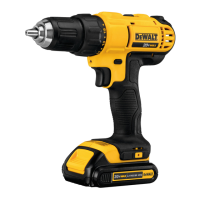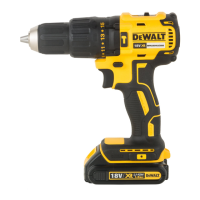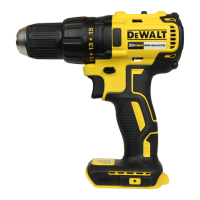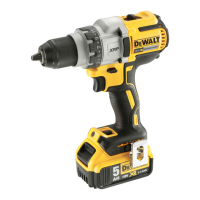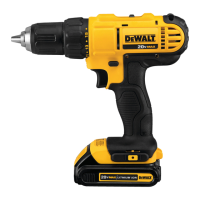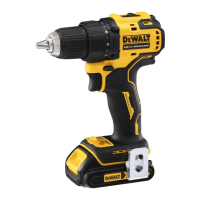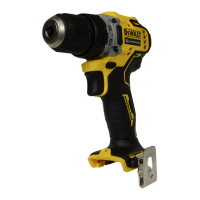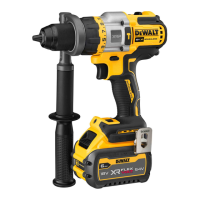13
ENGLISH
D
Cleaning
WARNING: Blow dirt and dust out of the main housing
with dry air as often as dirt is seen collecting in and around
the air vents. Wear approved eye protection and approved
dust mask when performing thisprocedure.
WARNING: Never use solvents or other harsh chemicals
for cleaning the non‑metallic parts of the tool. These
C
Lubrication
Your power tool requires no additionallubrication.
MAINTENANCE
Your power tool has been designed to operate over a long
period of time with a minimum of maintenance. Continuous
satisfactory operation depends upon proper tool care and
regularcleaning.
WARNING: To reduce the risk of serious personal
injury, turn tool off and disconnect battery pack
before making any adjustments or removing/
installing attachments or accessories. An accidental
start‑up can causeinjury.
The charger and battery pack are notserviceable.
Proper hand position requires one hand on the main handle
12
and one hand on the side handle
13
.
Screwdriver Operation (Fig.E)
1. Select the desired speed/torque range using the
three‑speed gear shifter
4
on the top of the tool. If using
the torque adjustment collar
3
, initially set the three‑speed
gear shifter to speed 2or 3. This ensures effective control
over the fastener allowing the screw to be seated correctly
and set to specification. Speed 1will provide the same
clutching torque as speeds 2and 3. However, for optimum
performance of the electronic clutch, speeds 2and
3arepreferred.
NOTE: Use the lowest torque setting (1) first and increase
the number through to the highest setting (11) to seat the
fastener at the desired depth. The lower the number, the
lower the torqueoutput.
2. Reset the torque adjustment collar
3
to the appropriate
number setting for the torque desired. Make a few practice
runs in scrap or unseen areas to determine the proper
position of the torque adjustmentcollar.
NOTE: The torque adjustment collar may be set to any number
at anytime.
Drill Operation (Fig.F)
WARNING: TO REDUCE THE RISK OF PERSONAL
INJURY, ALWAYS ensure workpiece is anchored or
clamped firmly. If drilling thin material, use a wood
“back‑up” block to prevent damage to thematerial.
1. Select the desired speed/torque range using the gear shifter
to match the speed and torque to the planned operation.
Set the torque adjustment collar
3
to the drillsymbol.
2. For WOOD, use twist bits, spade bits, power auger bits or
hole saws. For METAL, use high‑speed steel twist drill bits
or hole saws. Use a cutting lubricant when drilling metals.
The exceptions are cast iron and brass which should be
drilleddry.
3. Always apply pressure in a straight line with the bit. Use
enough pressure to keep the drill bit biting, but do not push
hard enough to stall the motor or deflect thebit.
Proper Hand Position (Fig.K)
WARNING: To reduce the risk of serious personal injury,
ALWAYS use proper hand position asshown.
WARNING: To reduce the risk of serious personal
injury, ALWAYS hold securely in anticipation of a
suddenreaction.
OPERATION
Instructions for Use
WARNING: Always observe the safety instructions and
applicableregulations.
WARNING: To reduce the risk of serious personal
injury, turn tool off and disconnect battery pack
before making any adjustments or removing/
installing attachments or accessories. An accidental
start‑up can causeinjury.
4. Hold tool firmly with both hands to control the twisting
action of thedrill.
5. IF DRILL STALLS, it is usually because it is being
overloaded. RELEASE TRIGGER IMMEDIATELY, remove
drill bit from work, and determine cause of stalling. DO NOT
CLICK TRIGGER OFF AND ON IN AN ATTEMPT TO START
A STALLED DRILL – THIS CAN DAMAGE THEDRILL.
6. Keep the motor running when pulling the bit back out of a
drilled hole. This will help preventjamming.
Hammerdrill Operation (Fig.G)
DCD997 Only
1. Select the desired speed/torque range using the gear shifter
to match the speed and torque to the planned operation.
Set the torque adjustment collar
3
to the hammersymbol.
2. Select the high speed 3setting by sliding the gear shifter
4
back (away form thechuck).
3. When drilling, use just enough force on the hammer to
keep it from bouncing excessively. Prolonged and too much
force on the hammer will cause slower drilling speeds and
potentialoverheating.
4. Drill straight, keeping the bit at a right angle to the work. Do
not exert side pressure on the bit when drilling as this will
cause clogging of the bit flutes and a slower drillingspeed.
5. When drilling deep holes, if the hammer speed starts to
drop off, pull the bit partially out of the hole with the tool
still running to help clear debris from thehole.
6. For masonry, use carbide‑tipped bits or masonry bits. A
smooth, even flow of dust indicates the proper drillingrate.
